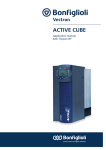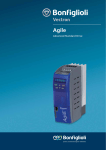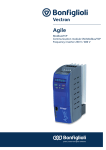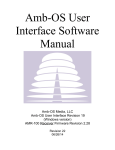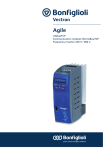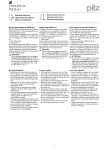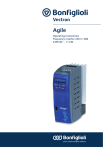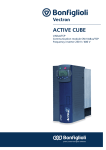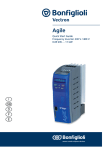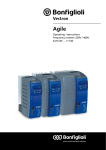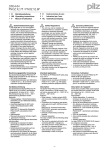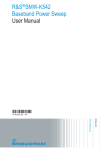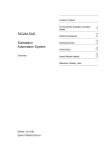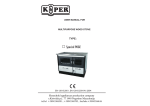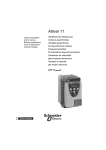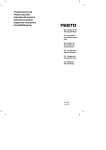Download AGL-Functional_Safety_VEC771R0-STO-V0-01SV0-05
Transcript
Agile Application manual Functional Safety General Information about the Documentation For the series of devices AGL (Agile) is for the safety-related commissioning and operation to be complied with the following documentation: • Operating instructions • This application manual When using a communication interface the corresponding manual is additional to be complied with. For the usage of further functions the corresponding application manuals must be complied with (in example for the integrated PLC function). This documentation was written in German language. The German documentation is the original one. Other language versions are translated. This application manual contains all relevant information required for using the safety-oriented function „Safe Torque Off“ (STO). For better clarity, the documentation is structured according to the customer-specific requirements made on the frequency inverter. Quick Start Guide The Quick Start Guide describes the basic steps required for mechanical and electrical installation of the frequency inverter. The guided commissioning supports you in the selection of necessary parameters and the software configuration of the frequency inverter. Operating Instructions The Operating Instructions describe and document all functions of the frequency inverter. The parameters required for adapting the frequency inverter to specific applications as well as the wide range of additional functions are described in detail. Application Manual The application manual supplements the documentation for purposeful installation and commissioning of the frequency inverter. Information on various subjects connected with the use of the frequency inverter is described specific to the application. If you need a copy of the documentation or additional information, contact your local representative of BONFIGLIOLI. AGL-STOV0-01SV0-05 06/12 3 CONTENT 1 2 3 General information about the documentation ............................................................. 6 1.1 Instruction manuals.................................................................................... 6 1.2 Pictograms and signal words used ............................................................. 7 1.3 Copyright .................................................................................................... 7 General Safety Instructions and Information on Use .................................................... 8 2.1 General Information ................................................................................... 8 2.2 Designated use ........................................................................................... 8 2.3 Transport and Storage ................................................................................ 8 2.4 Handling and installation ............................................................................ 9 2.5 Electrical Installation .................................................................................. 9 2.6 2.6.1 Information on Use ................................................................................... 10 Operation with products from other manufacturers ............................................ 10 2.7 Maintenance and service .......................................................................... 10 2.8 Disposal..................................................................................................... 10 Safety Instructions on Function „Safe Torque Off“ (STO) ........................................... 11 3.1 3.1.1 3.1.2 Approved Devices ..................................................................................... 12 Connection 3x AC 400/480 V ............................................................................ 12 Connection 1x AC 230 V / 3x AC 230 V ............................................................. 12 4 Information of Risk Analysis and Risk Assessment ..................................................... 13 5 General Description of Safety Function ....................................................................... 14 6 7 8 4 5.1 Integrated Safety Function ....................................................................... 14 5.2 Functional Safety ...................................................................................... 14 5.3 Classification the safety requirement ....................................................... 14 Description of ACTIVE Cube Safety Function ............................................................... 15 6.1 Definitions of the AGL Safety functions .................................................... 16 6.2 Specification of the Safety Function 1 (SF1): STO .................................... 17 6.3 Specification of the Safety Function 2 (SF2): SS1 .................................... 18 6.4 Description of Safety Function.................................................................. 19 6.5 Two-Channel Monitoring .......................................................................... 21 6.6 Diagnosis function and enforced dynamizing ........................................... 23 Requirements to be met by installation....................................................................... 23 7.1 Instructions on installation of safety equipment ..................................... 23 7.2 External Safety Control Equipment .......................................................... 24 7.3 7.3.1 External DC 24 V power supply ................................................................ 24 External DC 24 V voltage supply for group stop ................................................. 25 7.4 DC 24 V power supply by AGL ................................................................... 25 Requirements to be met in operation .......................................................................... 25 AGL-STOV0-01SV0-05 06/12 9 Requirements to be met by acceptance inspection ..................................................... 25 10 Application Examples ................................................................................................... 25 10.1 10.1.1 10.1.2 10.1.3 10.1.4 cabinet STO according to Stop Category 0 ............................................................ 26 STO Direct Stop .............................................................................................. 26 STO Direct Stop with error exclusion “short circuit” in the cabinet........................ 27 STO Direct Stop with Feedback to PLC .............................................................. 28 STO Direct Stop with Feedback to PLC with error exclusion “short circuit” in the 29 10.2 10.2.1 10.2.2 10.2.3 10.2.4 cabinet SS1 according to Stop Category 1 ............................................................ 30 SS1 Direct Stop ............................................................................................... 30 SS1 Direct Stop with error exclusion “short circuit” in the cabinet ........................ 31 SS1 Direct Stop with Feedback to PLC ............................................................... 32 SS1 Direct Stop with Feedback to PLC with error exclusion “short circuit” in the 33 10.3 Internal DC 24 V Supply, SS1 ................................................................... 34 10.4 Group Stop, SS 1 ....................................................................................... 35 11 Checklist ....................................................................................................................... 36 12 Safety Function Test Report......................................................................................... 37 12.1 Characteristical Data: ............................................................................... 37 13 STO status (diagnosis) ................................................................................................. 37 14 Change index ............................................................................................................... 38 15 Index ............................................................................................................................ 39 AGL-STOV0-01SV0-05 06/12 5 1 General information about the documentation The present documentation complements the operating instructions Agile (AGL). It contains additional safety information and requirements for the operation of Agile (AGL) in safety-oriented applications. Use in safety-oriented machines shall be permissible only after this documentation has been read carefully and understood. The applicable basic standards as well as application-specific and specific national standards shall also be complied with – the standards referred to in this manual shall also be complied with. 1.1 Instruction manuals For better clarity, the documentation is structured according to the customer-specific requirements made on the frequency inverter. Quick start guide The Quick Start Guide describes the basic steps required for mechanical and electrical installation of the frequency inverter. The guided commissioning supports you in the selection of necessary parameters and the configuration of the frequency inverter by the software. Operating instructions The Operating Instructions describe and document all functions of the frequency inverter. The parameters required for adapting the frequency inverter to specific applications as well as the wide range of additional functions are described in detail. Application manual The application manual supplements the documentation for purposeful installation and commissioning of the frequency inverter. Information on various subjects connected with the use of the frequency inverter is described specific to the application. If you need a copy of the documentation or additional information, contact your local representative of BONFIGLIOLI. The present documentation was prepared with great care and it was subjected to extensive and repeated reviews. For reasons of clarity, it was not possible to include all details of all types of the product in the documentation. Neither was it possible to consider all conceivable installation, operation or maintenance situations. If you require further information or if you meet with specific problems which are not dealt with in sufficient detail in the documentation, contact your national BONFIGLIOLI agent. We would also like to point out that the contents of this documentation do not form part of any previous or existing agreement, assurance or legal relationship. Neither are they intended to supplement or replace such agreements, assurances or legal relationships. The manufacturer's obligations are exclusively specified in the relevant purchase contract. This contract also contains all and any warranty regulations which may apply to the relevant scope of supply. These contractual warranty provisions are neither extended nor limited by the specifications contained in this documentation. The manufacturer reserves the right to correct or amend the specifications, product information and omissions in these operating instructions without notice. The manufacturer shall not be liable for any damage, injuries or costs which may be caused by the aforementioned reasons. This documentation was written in German language. Other language versions are translated. 6 AGL-STOV0-01SV0-05 06/12 1.2 Pictograms and signal words used The following pictograms and signal words are used in the documentation: Danger! Danger refers to an immediate threat. Non-compliance with the precaution described may result in death, serious injury or material damage. Warning! Warning refers to a possible threat. Non-compliance with the warning may result in death, serious injury or material damage. Caution! Caution refers to an indirect threat. Non-compliance may result in personal or material damage. Attention! Attention refers to a possible operational behavior or an undesired condition that can occur in accordance with the reference text. Note Note marks information that facilitates handling for you and supplements the corresponding part of the documentation. 1.3 Copyright This user manual is protected by copyright. It is solely intended for use by operating staff and must not be copied nor disclosed to third parties. AGL-STOV0-01SV0-05 06/12 7 2 General Safety Instructions and Information on Use Warning! The specifications and instructions contained in the documentation must be complied with strictly during installation and commissioning. Before starting the relevant activity, read the documentation carefully and comply with the safety instructions. The term “Qualified Staff” refers to anybody who is familiar with the installation, assembly, commissioning and operation of the frequency inverter and has the proper qualification for the job. 2.1 General Information Warning! The DC-link circuit of the frequency inverter is charged during operation, i.e. there is always the risk of contact with high voltage. Frequency inverters are used for driving moving parts and they may become hot at the surface during operation. Any unauthorized removal of the necessary covers, improper use, wrong installation or operation may result in serious injuries or material damage. In order to avoid such injuries or damage, only qualified technical staff may carry out the transport, installation, commissioning, setup or maintenance work required. The standards DIN EN 50178, IEC 60364 (Cenelec HD 384 or DIN VDE 0100), IEC 60664-1 (Cenelec HD 625 or VDE 0110-1), BGV A2 (VBG 4) as well as the applicable national regulations must be complied with. The term „Qualified Staff“ refers to anybody who is familiar with the installation, assembly, commissioning and operation of the frequency inverter as well as the possible hazards and has the proper qualification for the job. Persons not familiar with the operation of the frequency inverter or children must not have access to the device. 2.2 Designated use Warning! The frequency inverters are electrical drive components intended for installation in industrial plants or machines. Commissioning and start of operation is not allowed until it has been verified that the machine meets the requirements of the EC Machinery Directive 2006/42/EEC and DIN EN 60204. In accordance with the CE marking requirements, the frequency inverters comply with the Low Voltage Directive 2006/95/EEC as well as DIN EN 61800-5-1. The user shall be responsible for making sure that the requirements of the EMC Directive 2004/108/EEC are met. Frequency inverters are only available at specialized dealers and are exclusively intended for professional use as per DIN EN 61000-3-2. Any use other than the use described above, will be considered as not in accordance with the specified purpose and may result in the warranty becoming null and void. The frequency inverters are also marked with the UL label according to UL508c, which proves that they also meet the requirements of the CSA Standard C22.2-No. 14-95. The technical data, connection specifications and information on ambient conditions are indicated on the rating plate and in the documentation and must be complied with in any case. Anyone involved in any kind of work at the device must have read the instructions carefully and understood them before starting the work. 2.3 Transport and Storage The frequency inverters must be transported and stored in an appropriate way. During transport and storage the devices must remain in their original packaging. The units may only be stored in dry rooms which are protected against dust and moisture and are exposed to little temperature deviations only. Observe the conditions as per DIN EN 60721-3-1 for storage, DIN EN 60721-3-2 for transport and the labeling on the packaging. The duration of storage without connection to the permissible nominal voltage may not exceed one year. 8 AGL-STOV0-01SV0-05 06/12 2.4 Handling and installation Warning! Damaged or destroyed components must not be put into operation because they may be a health hazard. The frequency inverters are to be used in accordance with the documentation as well as the applicable directives and standards. It must be handled carefully and protected against mechanical stress. Do not bend any components or change the isolating distances. Do not touch electronic components or contacts. The devices are equipped with components which are sensitive to electrostatic energy and can be damaged if handled improperly. Any use of damaged or destroyed components shall be considered as a non-compliance with the applicable standards. Removal of seals from the housing can result in invalidation of warranty. Do not remove any warning signs from the device. 2.5 Electrical Installation Warning! Before any assembly or connection work, discharge the frequency inverter. Verify safe isolation from power supply. Do not touch the terminals because the capacitors may still be charged. Comply with the information given in the operating instructions and on the frequency inverter label. Follow the safety rules applying to work on electrical equipment. Follow the safety rules applying to work on electrical equipment: − Isolate: Isolate the installation from all possible sources of electrical power. − Secure against reconnection. Only the persons working on the installation may re-commission the relevant part of the installation. − Verify there is no electrical power: Using a measuring instrument or voltage tester, ensure there is no voltage against ground on the relevant plant component. − Ground and short-circuit: Starting from the ground terminal, connect all conductors to one another.1) − Cover und shield neighboring live parts: By covering, shielding or isolation of energized plant components contact with such parts is to be prevented. 1) Deviations from this are possible in certain circumstances. When working at the frequency inverters, comply with the relevant accident prevention regulations, the applicable standards BGV A2 (VBG 4), VDE 0100, standards governing work on systems with dangerous voltages (e.g. DIN EN 50178) and other national directives. Comply with the electrical installation instructions given in the documentation as well as the relevant directives. Responsibility for compliance with and examination of the limit values of the EMC product norm DIN EN 61800-3 for variable-speed electrical drive mechanisms is with the manufacturer of the industrial plant or machine. The documentation contains information on EMC-conforming installation. The cables connected to the frequency inverters may not be subjected to high-voltage insulation tests unless appropriate circuitry measures are taken before. Do not connect any capacitive loads. AGL-STOV0-01SV0-05 06/12 9 2.6 Information on Use Warning! The frequency inverter may be connected to power supply every 60 s. This must be considered when operating a mains contactor in jog operation mode. For commissioning or after an emergency stop, a non-recurrent, direct restart is permissible. After a failure and restoration of the power supply, the motor may start unexpectedly if the AutoStart function is activated. If staff is endangered, a restart of the motor must be prevented by means of external circuitry. Before commissioning and the start of the operation, make sure to fix all covers and check the terminals. Check the additional monitoring and protective devices according to DIN EN 60204 and applicable the safety directives (e.g. Working Machines Act, Accident Prevention Directives etc.). No connection work may be performed, while the system is in operation. 2.6.1 Operation with products from other manufacturers Please note that Bonfiglioli Vectron will not accept responsibility for compatibility with products from other manufacturers (e.g. motors, cables, filters, etc.). In order to achieve optimum system compatibility, Bonfiglioli Vectron offers components which ensure easy commissioning and are perfectly adjusted to one another in operation. Use of the device with products from other manufacturers will be at your own risk. 2.7 Maintenance and service Warning! Unauthorized opening and improper interventions can lead to personal injury or material damage. Repairs on the frequency inverters may only be carried out by the manufacturer or persons authorized by the manufacturer. Check protective equipment regularly. Any repair work must be carried out by qualified electricians. 2.8 Disposal The components of the frequency inverter must be disposed of in accordance with the applicable local and national laws, regulations and standards. 10 AGL-STOV0-01SV0-05 06/12 3 Safety Instructions on Function „Safe Torque Off“ (STO) The function „Safe Torque Off“ (STO) is a functional safety provision, i.e. it protects persons from damage, provided that projecting, installation and operation are performed properly. This function does not disconnect the machine from power supply. The safety function “Safe torque off” (STO) can be used to realize an “Emergency Stop” according to EN 60204 while the power supply is still active on the frequency inverter A provision must be provided for disconnecting the machine from power supply for maintenance work. With a suitable external safety control device the function „Safe Stop 1 (SS1 c)“ according to EN 61800-5-2 can be realized together with the AGL. Danger! Improper installation of the safety technique can cause an uncontrolled starting of the drive. This may cause death, serious injuries and significant material damage. Safety functions may only be installed and commissioned by qualified staff. The STO function is not suitable for emergency switch off as per EN 60204. An emergency switch off can be realized by installing a mains contactor. An emergency stop according to EN 60204 must be functioning in all operation modes of the frequency inverter. Resetting of an emergency stop must not result in uncontrolled starting of the drive. The drive is started again when the function STO is no longer triggered. In order to comply with standards EN 60204 and EN 1037, it must be ensured by taking external measures that the drive only starts after e manual confirmation. Without a mechanical brake, the drive might not stop immediately but coast to a standstill. If this may result in personal or material damage, additional safety measures must be taken. If persons may be endangered after disconnection of the motor control by STO, access to the hazard areas must be prevented until the drive has stopped. Check the safety function at regular intervals according to the results of your risk assessment. BONFIGLIOLI VECTRON recommends that the check is performed after one year, at the latest. The STO function is one fault fail-safe. No single fault or component failure can cause a disabled drive to produce motor shaft torque. Only in extremely unlike combinations of component faults the motor shaft could move jerky with sudden acceleration (maximum 180°/number of pole pairs, for example jerky movement of 90° for 4-pole motor, 180°/2) and produce torque. It must be checked if this behavior can cause a dangerous machine movement. If the STO function is used, the special safety, installation and instructions on use instructions shall be complied with. AGL-STOV0-01SV0-05 06/12 11 Warning! Dangerous voltage! After disconnection of an external DC 24 V power supply, the DC link of the frequency inverter is still connected to mains supply. Even if the motor control is deactivated and the motor is coasting to a standstill or has already stopped, high voltages may still be present on the motor terminals. Before working (e.g. maintenance) on live parts, the machine must always be disconnected from mains supply (main switch). This must be documented on the machine. When the function “Safe Torque Off” is triggered, the motor is not isolated from the DC link of the frequency inverter. High voltage levels may be present at the motor. Do not touch live terminals. Permanent magnet synchronous motors (PMSM) must be operated only up to the synchronous speed. PMSM cannot be operated above the synchronous speed because the trigger of the STO function can lead to the destruction of the power stage. 3.1 Approved Devices The following device variants of the Agile device series are approved for applications with functional safety. Additional to the below mentioned Type codes, the name plate of these devices contains a “STO certified” logo. 3.1.1 Connection 3x AC 400/480 V AGL402-XX1-XXXXXXXS AGL402-XX2-XXXXXXXS AGL402-XX3-XXXXXXXS With X as placeholder. 3.1.2 Connection 1x AC 230 V / 3x AC 230 V AGL202-XX1-XXXXXXXS AGL202-XX2-XXXXXXXS AGL202-XX3-XXXXXXXS With X as placeholder. 12 AGL-STOV0-01SV0-05 06/12 4 Information of Risk Analysis and Risk Assessment According to the Machinery Directive 2006/42/EC, the manufacturer of a machine is obliged to carry out a risk analysis in order to identify the hazards related to the machine. The Standard EN 12100 – Safety of machinery - General principles for design - Risk assessment and risk reduction describes the information required for risk assessment. Risk assessment is effected according to the following criteria: − degree of injury (serious/minor) − frequency or duration of stay (frequent/seldom) − possibilities of avoidance (hardly possible/possible) For defined risks the Standards EN ISO 13849-1, IEC 61508 or EN 954-1 can be used to accomplish a correct classification into Safety category, SIL (Safety Integrated Level) or PL (Performance Level). These standards contain design principles for safety-relevant parts of control systems. In the case of the safety function “Safe Torque Off”, the risk assessment must consider the fact that the motor will coast to a standstill in the case of an error. Depending on the application, a mechanical brake may be required. Responsibility: The Manufacturer shall be responsible for the safety of the machine. − risk analysis of hazards originating from the machine − measures for reduction and elimination of the risks − documentation of residual risk from the point of view of the manufacturer − selection of suitable controller, installation of protective equipment, ergonomics, documentation, warning of remaining risks The operator of the machine is responsible for the safety of the application. − risk analysis of hazards originating from the use of the machine − documentation of residual risk from the point of view of the operator − safe operation and protection of operating staff (barriers, instruction of operating staff, etc.) Selection of safety function: − Risk analysis and risk assessment for machine (EN 12100) − Risk reduction by machine design − If not possible by design: risk reduction by protective equipment − Identification of safety requirements − Selection of category of safety function AGL-STOV0-01SV0-05 06/12 13 5 General Description of Safety Function 5.1 Integrated Safety Function Electronic protection systems are integrated in the drive control system and perform safety functions in order to minimize or eliminate hazards caused by functional errors of machines. The integrated safety functions replace time-consuming and expensive installation of external safety components. The safety function can be requested or triggered by an error. In hazard areas, setup work or work for elimination or errors may be required where the safety function is not to be activated by isolating protection devices such as mains contactors or motor contactors. Here, the additional safety function may be used. STO can be used as an alternative to mains or motor contactors, which can be omitted dependent on the application. The integrated safety functions reduce the risk of personal damage in hazard areas and reduce installation requirements. 5.2 Functional Safety The safety function of the control system must be ensured for normal, trouble-free operating sates as well as in the case of an error. As a result of this requirement: − The safety function must be checked in case errors are present. Possible methods include: error tree analysis, FMEA, etc.) u. a. 5.3 Classification the safety requirement The integrated safety function “Safe Torque Off” of the AGL frequency inverter meets the following requirements according to EN 61800-5-2: − up to safety integrity level SIL 2 according to DIN EN 61508 for STO − up to performance level d according to EN 13849-1 − of category 3 according to EN ISO 13849-1 In the case of an error, thanks to the safety function STO, the frequency inverter does not supply energy to the motor which would cause a revolution or torque (or a movement or force in the case of a linear motor). Characteristic for the classification mentioned above: − If an error occurs, the safety function is maintained. With a suitable external safety control device the function „Safe Stopp 1 (SS1 c)“ according to EN 61800-5-2 can be realized together with the AGL. By using appropriate safety control devices, stop category 0 and stop category 1 according to EN 60204 can be achieved in the machine. For safety control devices, please refer to chapter 10. Stop category 0: Stop by immediate disconnection of energy supply to the machine drive elements, i.e. uncontrolled stop. Stop category 1: Controlled stop, where energy is still being supplied to the drive elements of the machine to perform the stopping operation. Energy supply is stopped only after the drive has come to a standstill. Note that the drive may not stop immediately but coast to a standstill. If no mechanical brake is installed, or a defective brake may involve a risk, further protective measures (in example tumbler) are to be taken. 14 AGL-STOV0-01SV0-05 06/12 6 Description of ACTIVE Cube Safety Function The frequency inverters of the AGL devices series feature the integrated safety function „Safe torque off, STO“. With a suitable external safety control device the function „Safe Stopp 1 (SS1 c)“ according to EN 61800-5-2 can be realized together with the AGL. Definitions according to EN 61800-5-2: STO: Dem Motor wird keine Energie zugeführt, die eine Drehung (oder bei einem Linearmotor eine Bewegung) verursachen kann. Der Frequenzumrichter liefert keine Energie an den Motor, die ein Drehmoment erzeugen kann. SS1 c: Das System Sicherheitsschaltgerät + Frequenzumrichter führt die Funktion aus: Auslösen der Motorverzögerung und nach einer anwendungsspezifischen Zeitverzögerung Auslösen der STO-Funktion. Diese Sicherheitsfunktion entspricht dem gesteuerten Stillsetzen nach EN 60204-1, Stopp-Kategorie 1. Definitions according to EN 60204-1: Stop category 0: Stop by immediate disconnection of energy supply to the machine drive elements, i.e. uncontrolled stop. Stop category 1: Controlled stop, where energy is still being supplied to the drive elements of the machine to perform the stopping operation. Energy supply is stopped only after the drive has come to a standstill. Stop functions must always have priority over start functions and must work properly in any operation mode. Resetting of the stop function must not cause any dangerous state. The mechanical elements must be dimensioned properly for the stop category used. If, for example, a mechanical brake is applied in the case of fast-rotating machines via stop category 0, this brake must be able to stop the machine safely. Wear and tear of the mechanical elements must be considered during projection for the operating states and indicated in the maintenance instructions. Stop category 0 always has priority over stop category 1. AGL-STOV0-01SV0-05 06/12 15 6.1 Definitions of the AGL Safety functions SF1: Safety Function 1 SF2: Safety Function 2 DF1: Diagnosis function 1 DF2: Diagnosis function 2 Response time: Time that elapses between the triggering of the Safey function on the user interface and reaching the safe state. Example for STO: On the user interface the signal level switches from above DC 15 V to less than DC 5 V. Latest when falling below DC 5 V the response time begins and ends at the moment where torque can no longer be generated. Fault Response time: Time between the occurrence of a detectable fault and reaching the safe state of the frequency inverter. Example: The Safety function STO can no longer be triggerd via channel A. The device internal diagnosis detects the fault and initiates the necessary fault reaction functions. Overall the Fault response time elapses until torque can no longer be generated. 16 AGL-STOV0-01SV0-05 06/12 6.2 Specification of the Safety Function 1 (SF1): STO Type of Safety function SF1 According to EN 61800-5-2: Active Principle of SF1 Demand rate SIL-Level (IEC 61508) Redundancy Performance Level (EN ISO 13849-1) Kategorie (EN ISO 13849-1) Amount of Processs interfaces Design of Processs interface Type of Processs interfaces Operation modes with functionality of SF 1 Response time SF1 Fault Reaction time DF1 V t t1 AGL-STOV0-01SV0-05 06/12 Safe Torque Off, STO Disconnection of energy supply to the motor High 2 On two channels (2) d 3 Two (2) Two yellow marked spring terminals X11.3 and X13.3 (inputs STOA und STOB) SPS-Type 1 compatible according to IEC61131-2 limited None Less than or equal to 150 ms Less than or equal to 220 ms Speed axis Time axis Time frame, when STO is triggered Area of discontinuation 17 6.3 Specification of the Safety Function 2 (SF2): SS1 Type of Safety function SF2 According to EN 61800-5-2: Active Principle of SF2 Safe Stop 1, SS1 c • Delay of motor with suitable braking ramp • Disconnection of energy supply to the motor after elapsing of a safe time delay Demand rate High SIL-Level (IEC 61508) 2 with suitable safety switching device Redundancy On two channels (2) Performance Level (EN ISO 13849-1) d with suitable safety switching device Amount of Processs interfaces • External safety switching device according to requirements of risk analysis • Two (2) on AGL Design of Processs interface • External safety switching device according to requirements of risk analysis • Two yellow marked spring terminals X11.3 and X13.3 (inputs STOA und STOB) Type of Processs interface STO SPS-Type 1 compatible according to IEC61131-2 Operation modes with limited func- None tionality of SF 2 Response time SF2 • External safety switching device: according to data sheet of device • AGL: Less than or equal to 150 ms Fault Reaction time DF2 • External safety switching device: according to data sheet of device • AGL: Less than or equal to 220 ms The security function corresponds to a controlled stop to EN 60204-1, Stop Category 1. V t t1 t2 Δt 18 Speed axis Time axis Time frame, when braking ramp is triggered (non safe path) Time frame, when STO is triggered Time between activation of braking ramp and triggering STO Are of maximum braking Time, Set up on external safety control device. Area of discontinuation AGL-STOV0-01SV0-05 06/12 6.4 Description of Safety Function In the case of an error or if requested, the power semiconductors of the frequency inverter will be switched off. After this, the frequency inverter does not supply energy to the drive which would cause a revolution or a torque (or a movement or force in the case of a linear drive). Mains voltage is still present. If an error occurs, the machine can still be (or remain) switched off safely. Unlike shut-down via mains contactors or motor contactors, the integrated safety function enables easy combination of drives in a machine to form functional groups. The Safe Torque Off can be limited to certain plant areas in this way. Another advantage is the fact that it is not necessary to wait until the frequency inverter has been charged and discharged. Thus, readiness of the machine for operation can be restored more quickly. Regular electro mechanic equipment are wearing out – through the usage of the STO functionality, this kind of equipment is no longer necessary and maintenance costs can be reduced. Safe Torque Off: − Energy supply for the rotary field of the motor is interrupted; the motor coasts to a standstill − Used if monitoring for standstill is not required − Accidental start of the motor is prevented − No galvanic isolation of motor from frequency inverter DC link Traditional System Integrated System with AGL and usage of STO Mains Frequency inverter K1 M AGL-STOV0-01SV0-05 06/12 19 Further advantages: − Contactors on motor side not required, reduced installation requirements, less components, more space in electrical cabinet − Simple realization with external safety control device for Stop-Category 0 − With a suitable external safety control a functional safety according to Stop Category 1 can be achieved − The drive can be connected to power supply continuously; communication and parameter configuration of the frequency inverter are maintained while the torque is disabled With a suitable external safety control device the function „Safe Stopp 1 (SS1 c)“ according to EN 61800-5-2 can be realized together with the AGL. Easier machine approval, because the safety function is certified via a type examination check. Triggering of function “Safe Torque Off” Safe Torque Off can be achieved by: − Intentional triggering during operation in order to stop a drive and safely prevent restarting, e.g. for maintenance work on a machine. − Triggering by actuation of an emergency stop switch or monitoring of protective systems, e.g. safety door. − Detection of an error. The drive may only start again after the error has been acknowledged and eliminated. Actuation of safety relay Safe Torque Off Detection of an error through self-diagnosis Application example: The danger zone near a transport conveyor is monitored by a light grid. If anybody enters the danger zone, the light grid is interrupted. The DC 24 V supply for the digital inputs STO of the function „Safe Torque Off“ is switched off and the frequency inverter output stage is disabled. The drive coasts to a standstill. Disconnection from mains supply is not necessary. Communication via field bus or addressing via the terminals is still possible. An external brake which stops the motor can be addressed. 20 AGL-STOV0-01SV0-05 06/12 6.5 Two-Channel Monitoring The STO function (Safe torque off) is realized via two channels in the frequency inverter (redundant design). Via two redundant monitored stop paths with no-voltage release (STOA and STOB), the frequency inverter is switched off safely even if an error occurs and the control voltage fails at the same time. Thus, the drive does not generate further torque. An active movement is not stopped by the function. Externally generated movements (such as a stroke movement by weight) must be switched off safely by external means (for example, mechanical brake). Triggering can be effected, for example, via a two-channel contactor control with two release circuits and redundant disconnection of the main current or via a sensor or emergency stop switch with two contacts and separate cable routing to the evaluation unit. Via the digital inputs STOA (X11.3) and STOB (X13.3), two DC 24 V control voltages of a protection device are applied. If the protection device is actuated, the control voltages are interrupted, the energy supply to the motor is switched off. Disconnection is effected at a delay according to chapter 6.2. If the function STO is triggered, the high level controller (PLC) has no more influence on the inverter release1 in the frequency inverter. To restart, the inverter release is enabled by the release by the user or by the superior PLC. An error inside the STO self monitoring is identified and can then be repaired (e.g. by replacing of a unit). Internally in the device the two stop paths are monitored cyclically beginning with the terminal and ending with the power semiconductor. Both stop paths are designed identically. One single error will not result in a failure of the safety function. The test required for monitoring is performed by the frequency inverter automatically. If the test results negative, the frequency inverter cannot be switched on anymore. Starting is possible again only after the frequency inverter was completely disconnected from voltage supplies and error has been corrected. 1 If the inverter release is interrupted, a motor revolving field can no longer be generated in this state. AGL-STOV0-01SV0-05 06/12 21 Truth table In the truth table, the states of the safety-relevant inputs STOA and STOB for activation and deactivation of the safety function STO are listed. STOA STOB 0 0 0 1 1 0 1 1 Truth table Description of state Safety function “Safe Torque Off” (STO) has been triggered. The frequency inverter signals no error in STO function. The inverter release is interrupted. STO is triggered. Monitoring for error in frequency inverter or external circuitry (5-second monitoring). After 5 seconds, an error is signaled. The inverter release is interrupted. STO is not triggered. Release for operation. Only in this state starting signals are accepted by the frequency inverter and lead to a switching of the modulation. 5-second monitoring It will be checked if the two inputs STOA or STOB are switched on within an interval of less than 5 sec for requesting the release of the frequency inverter output stages. If function STO is triggered by removing one of the signals from inputs STOA or STOB, the status changes to “STO triggered” and the output stage is inhibited. In this state the monitoring function checks, that during the next 5 seconds the second input is switched off. If this has not been done within 5 s after occurrence of this state, an error is triggered (5-second monitoring). − Different signal states on inputs STOA or STOB start the 5-second monitoring − Within 5 seconds, the same signal must be present of both inputs, otherwise an error will be signaled (F1205) − If the STO function is triggered on one channel, in the next following 5 s the STO function must be triggered on both channels. The error F1205 can be acknowledged using the Fault reset to reset the drive. Behavior of frequency inverter after start − Initialization − Monitoring for release request (5-second monitoring) − Preparation of release (check of stop paths) − Release of frequency inverter Behavior of frequency inverter in the case of an error 22 − Switch off of IGBT in power output stage by disconnection of optocoupler supply voltage − Suppression of control pulses of IGBT − Setting of error bit with possibility of transfer to overriding controller − Setting of digital output for error message − Release of digital input for error acknowledgement. AGL-STOV0-01SV0-05 06/12 6.6 Diagnosis function and enforced dynamizing The test required for monitoring the stop paths is performed by the frequency inverter automatically. Via automated enforced dynamizing, the stop paths are checked for errors. If the test result is negative, the frequency inverter cannot be switched on anymore, and an error of the group “F12” (in example F1201) is signaled. Starting is possible again only after the frequency inverter was completely disconnected from voltage supplies and error has been corrected. 7 Requirements to be met by installation 7.1 Instructions on installation of safety equipment − If work is to be carried out on live components, it must be possible to disconnect the machine from mains supply by means of a main switch. − According to EN 61800-5-2 a fault exclusion can be considered with one of the following possibilities: o The conductor is installed permanently and in example protected against external damage with a cable duct or reinforcement. o Single multi-conductors are used. o The conductors are situated in an electrical cabinet. o The conductors are shielded independently and have grounding. If applicable, the requirements of EN 60204-1 have to be considered to install the connectors correctly. − Protection against dirt is ensured if the frequency inverter and safety control equipment is installed in electrical cabinets with high IP protection, e.g. IP 54. − If external forces act on the drive axis, e.g. in the case of vertical axes (suspended loads) or round axes with asymmetrical weight distribution, mechanical brakes must be installed additionally. − Only use voltage sources with safe disconnection (SELV/PELV) according to VDE0100. Comply with the specifications in chapter 7.3 . − The STO inputs may be controlled with pulsed signals, neg. Puls lengths < 500 μs. − Errors can be excluded in the case of the Agile units because the terminal blocks for the STO function are physically separate from one another. The signal cables between the safety control equipment and ACTIVE Cube must either be physically separate from one another or suitable, cross fault proof cables. − Comply with applicable EMC instructions mentioned in the operating instructions. − After installation, check the safety function and error reaction and issue an acceptance report. − Interrupting the STO signals prevents a start of the motor. According to EN 60204-1, STO must not be released during an impending endangerment. − Also comply with the instructions on external safety control equipment. − During commissioning, check the safety function. Select the dimensions of the safety application such that the input current according to the operating instructions is available for each of the inputs STOA and STOB (typical: 10 mA). If more than one Agile frequency inverters are connected to one safety control device, the safety control device must provide sufficient power for all of them. AGL-STOV0-01SV0-05 06/12 23 7.2 External Safety Control Equipment Safety control equipment, upon request (e.g. actuation of emergency stop or access to hazard area, must trigger appropriate responses in order to protect people, the machine and the environment. They evaluate sensor signals or safely switch off dangerous states. External safety control devices must meet the following requirements: − External safety control equipment and safety modules for control of the digital inputs (STO) must meet one of the following classifications, to meet the classification of the ACU device: o PL d according to EN ISO 13849-1 o SIL 2 according to IEC 61508 o the whole installation meets these requirements. − The switching capacity of the safety control equipment must be designed for the maximum permissible, limited output current of the DC 24 power supply. Comply with the instructions of the manufacturer of the safety control equipment on the permissible contact load and any safeguards to be provided for the safety contacts. − The emergency stop device must comply with Standard EN ISO 13850. − If a safety request (e.g. emergency stop actuated or sensor signals that safety door is open) is reset (emergency stop unlocked, safety door closed) this alone shall not result in a restart of the drive. Restart may only occur after the safety control device has been reset. External safety control devices evaluate sensors: Examples of contact sensors: − Emergency stop control device for stop in dangerous situations − Position switch, e.g. for monitoring slide doors, safety grids or moving machine parts Examples of no-contact sensors: − Light barriers, e.g. for monitoring areas with dangerous movements − Light curtains 7.3 External DC 24 V power supply During projection and installation of a DC 24 V supply connected to the frequency inverter comply with the following instruction. This also includes supply of a safety control device the output of which is connected to a control input (including STOA and STOB) of the frequency inverter. Attention! 24 Use a suited SELV/PELV voltage supply, which rated voltage has to be DC 24 V ±10 %. The largest overvoltage must not exceed DC 32 V in the case of a fault (one fault safety) . The one fault safety has to be realized with an overvoltage protection of the mains supply (overvoltage protection OVP with limiting the output voltage to a maximum of DC 32 V) or an external wiring like a Crowbar. An adequate overvoltage category of the voltage supply has to be ensured. AGL-STOV0-01SV0-05 06/12 7.3.1 External DC 24 V voltage supply for group stop When multiple frequency inverters should be switched off by on DC 24 V voltage supply, the overall current consumption of the STO inputs must be determined. Please check the operating instructions for the current consumption. Typical is 10 mA for each STO input for each device. Dimension the cable cross sections according to the calculated current in compliance with the maximum connectable cable cross sections. 7.4 DC 24 V power supply by AGL You can use terminal X11.1 (DC 24 V supply) and X11.2 (GND) in order to supply a safety control device. Only use the power supply for the device connected to the frequency inverter. Other safety control devices must not be connected. The maximum output current is 100 mA. All further connected components (in example displays of digital outputs) and the safety control device must not have higher current requirements. 8 Requirements to be met in operation During operation, the projected and commissioned machine components must not be changed. If the machine is modified a new acceptance inspection is required. Check the safety function at regular intervals. The test intervals are to be determined according to the risk analysis. However, the check should be performed once every year, at the latest. 9 Requirements to be met by acceptance inspection The acceptance inspection of the safety function is ordered by the manufacturer of the machine. The inspection (acceptance, validation) shall be performed by a properly qualified person. The result of the inspection is to be documented and must be signed by the inspector. Each safety function must be documented in detail in this report. The inspections also include the machine documentation, including its safety functions. The safety functions must be checked particularly during the inspection and documented in the inspection report. Parameter settings shall be attached to the report. Further documents shall be added, as required, depending on the machine. Depending on the result of the risk analysis, inspection reports of the regular inspections shall be issued and signed by the inspector. 10 Application Examples The following examples illustrate how the functions “Safe Torque Off (STO)” and “Safe Stop 1 (SS1)” work. According to EN 60204, stop functions are divided in different categories. By suitable safety control devices, stop categories 0 and 1 can be realized in combination with the frequency inverter ACU. AGL-STOV0-01SV0-05 06/12 25 10.1 STO according to Stop Category 0 10.1.1 STO Direct Stop The Application example shows the minimum circuitry for Agile Frequency inverter for realization of the safety function STO – “Safe Torque Off” with an emergency stop device in a common electrical cabinet according to EN ISO 13849-1 PL d and Category 3 or IEC 61508 SIL 2. When operating the emergency stop device with two stop channels both release paths paths STOA and STOB of the Agile frequency inverter are interrupted and the integrated safety function is triggered by interrupting the inverter release. A (nonsafe) feedback to a process control can be done via a connected field bus. When STO is requested, the process controller can no further influence the inverter release inside the frequency inverter. Note: 26 Terminal X11.1 can be used for DC 24 V supply of the safety control unit. Please comply with chapter 7.3.1. AGL-STOV0-01SV0-05 06/12 10.1.2 STO Direct Stop with error exclusion “short circuit” in the cabinet The application circuit shows a drive control system with safety module according to EN ISO 13849-1 PL d and Category 3 or IEC 61508 SIL 2. Safety control equipment with one enable path and interconnection line is implemented instead of safety control equipment with two enable paths. Comply with the following conditions: − Safety control equipment and inverter have to be placed in the same cabinet. − Error exclusion in case of short circuit has to be ensured for wiring between safety control equipment and inverter (for example insulated conductor). AGL-STOV0-01SV0-05 06/12 27 10.1.3 STO Direct Stop with Feedback to PLC The application example shows a drive control system with PLC and safety module according to EN ISO 13849-1 PL d and category 3 or IEC 61508 SIL 2. A PLC performs the process control of the frequency inverter and can start the drive profiles via commands. If the protective device is actuated, e.g. safety door open, the release paths of the safety module are interrupted. Through the interruption of the control voltages on stop paths STOA and STOB of the frequency the integrated safety function with SIL 2 according to EN-61800-5-2 is activated by interrupting the inverter release. The safety module monitors the function of the switches S1 and S2 which are located outside of the electrical cabinet. 28 AGL-STOV0-01SV0-05 06/12 10.1.4 STO Direct Stop with Feedback to PLC with error exclusion “short circuit” in the cabinet The application circuit shows a drive control system with PLC and safety module according to EN ISO 13849-1 PL d and Category 3 or IEC 61508 SIL 2. Safety control equipment with one enable path and interconnection line is implemented instead of safety control equipment with two enable paths. Comply with the following conditions: − Safety control equipment and inverter have to be placed in the same cabinet. − Error exclusion in case of short circuit has to be ensured for wiring between safety control equipment and inverter (for example insulated conductor). AGL-STOV0-01SV0-05 06/12 29 10.2 SS1 according to Stop Category 1 10.2.1 SS1 Direct Stop The Application example shows the minimum circuitry for Agile Frequency inverter for realization of the safety function Safe Stop 1 (SS1) with an emergency stop device in a common electrical cabinet according to EN ISO 13849-1 PL d and Category 3 or IEC 61508 SIL 2. When the emergency stop device is actuated, the travel command “Clockwise” is reset first. After a delay tv, the contacts on the safety switch interrupt the two enable paths STOA and STOB of the Agile frequency inverter and the integrated safety function is triggered. The delay time is set on the safety control device and must be selected according to the application. The set delay time has to be slightly higher than the shut down time. A (non-safe) feedback to a process controller can be effected, for example, via a connected field bus. If STO is requested, the overriding controller has no more influence on the inverter release in the frequency inverter. 30 AGL-STOV0-01SV0-05 06/12 10.2.2 SS1 Direct Stop with error exclusion “short circuit” in the cabinet The application circuit shows a drive control system according to EN ISO 13849-1 PL d and Category 3 or IEC 61508 SIL 2 with PLC and safety module. Safety control equipment with one enable path and interconnection line is implemented instead of safety control equipment with two enable paths. Comply with the following conditions: − Safety control equipment and inverter have to be placed in the same cabinet. − Error exclusion in case of short circuit has to be ensured for wiring between safety control equipment and inverter (for example insulated conductor). AGL-STOV0-01SV0-05 06/12 31 10.2.3 SS1 Direct Stop with Feedback to PLC The application example shows a drive control system with PLC and safety module according to EN ISO 13849-1 PL d and category 3 or IEC 61508 SIL 2. A PLC performs the process control of the frequency inverter and can start the drive profiles via commands. If the protective device is actuated, e.g. safety door open, the release paths of the safety module are interrupted. The PLC is triggered first, that the safety function was actuated, which then decelerates the motor by resetting the start command (“Start CW” or “Start CCW”). After the delay time tv has elapsed the control terminals connected to STOA and STOB interrupt the inverter release of the inverter and the internal safety function STO is triggered by interrupting the inverter release. The safety module monitors the function of the switches S1 and S2 which are located outside of the electrical cabinet. 32 AGL-STOV0-01SV0-05 06/12 10.2.4 SS1 Direct Stop with Feedback to PLC with error exclusion “short circuit” in the cabinet The application circuit shows a drive control system with PLC and safety module according to EN ISO 13849-1 PL d and Category 3 or IEC 61508 SIL 2. Safety control equipment with one enable path and interconnection line is implemented instead of safety control equipment with two enable paths. Comply with the following conditions: − Safety control equipment and inverter have to be placed in the same cabinet. − Error exclusion in case of short circuit has to be ensured for wiring between safety control equipment and inverter (for example insulated conductor). AGL-STOV0-01SV0-05 06/12 33 10.3 Internal DC 24 V Supply, SS1 The application example shows the minimum circuitry for ACTIVE cube frequency inverters for realization of the safety function with an emergency stop switch in a common electrical cabinet. Supply of the safety control device is effected by the internal DC 24 V supply (max. 100 mA for all connected consumers). When the emergency stop switch is actuated, the travel command “Clockwise” is reset first. After a delay tv, the contacts on the safety switch interrupt the two enable paths STOA and STOB of the ACTIVE Cube frequency inverter and the integrated safety function is triggered by interrupting the inverter release. The delay time is set on the safety control device and must be selected according to the application. The delay time is set on the safety control device and must be selected according to the application. The set delay time has to be slightly higher than the shut down time. A (non-safe) feedback to a process controller can be effected, for example, via a connected field bus. If STO is requested, the overriding controller has no more influence on the pulse block in the frequency inverter. 34 AGL-STOV0-01SV0-05 06/12 10.4 Group Stop, SS 1 The application circuit shows a drive control system with PLC and safety module according to EN ISO 13849-1 PL d and Category 3 or IEC 61508 SIL 2. A PLC performs the process control of the frequency inverter and can start the drive profiles via commands which are communicated through the field bus. If the protective device is actuated, e.g. emergency stop switch, the enable paths of the safety module are interrupted. At first, the travel signal “Clockwise” is reset. Then, the motors are decelerated in a controlled way. After a delay tv, the controller enable signal of the frequency inverters is interrupted via the disconnection of the control voltages from STOA and STOB and the integrated safe pulse block is activated. Via the field bus, the (non-safe) feedback is transmitted to the PLC indicating that the drives have stopped. Except for the terminals shown in the diagram, no further terminals are required for connection. Note, that with high current demand a fuse leading to the safety contacts might be necessary according to the instructions of the safety device manufacturers. The external DC 24 V supply must be dimensioned accordingly, see chapter 7.3.1. In group stop setups pulsed signals could lead to more frequent false trippings. AGL-STOV0-01SV0-05 06/12 35 11 Checklist This list provides an overview of the requirements to be met in installation, commissioning and operation of the safety function Depending on the application, additional requirements must be met. Complete this list according to your application. Risk analysis: − was performed? − requires the use of the safety function “Safe Torque Off” requires category 3 according to the following classifications: - PL d (or smaller) according to EN ISO 13849-1 - Category 3 (or smaller) according to EN ISO 13849-1 - SIL 2 (or smaller) according to IEC 61508 − considers the stopping behavior of the Agile frequency inverter − permits coasting of the drive to a standstill or requires the installation of a mechanical brake. − considers the access time to the hazard area − defines intervals for regular functional checks of the safety function Installation: − EMC instructions in the operating instructions considered? − The DC 24 V supply was selected and installed based on the requirements of this manual? − The shield of the 24 V power supply was connected on both sides? − Emergency stop devices meet the following classifications: - PL d (or smaller) according to EN ISO 13849-1 - Category 3 (or smaller) according to EN ISO 13849-1 - SIL 2 (or smaller) according to IEC 61508 − Emergency Stop devices have a cross fault monitoring (2-channel connection) or protected wiring? − It is ensured that resetting of the safety control device alone does not result in a restart of the drive. − It is ensured that no voltage higher than DC 30 V can occur on the terminals of the control electronic unit (voltage resistance) − The protection against unexpected restart is set up. Commissioning: − Functional check of safety function performed? − Wiring of safety components checked? − Acceptance report issued? Operation: 36 − The machine must be operated only inside the specified limits. − The safety function is checked regularly. AGL-STOV0-01SV0-05 06/12 12 Safety Function Test Report The saftey function STO (Safe Torque Off) described in this manual was assessed and certified by TÜV Rheinland Industrie Service GmbH. Test institute Test report no. Test sample Basis of test TÜV Rheinland Industrie Service GmbH 968/M 355.00/12 Frequency inverter Agile series, concept inspection IEC 61508 Teil 1-7:2010 (as far as applicable) EN ISO 13849-2:2008 + AC:2009 (as far as applicable) EN 62061:2005 EN 61800-5-1:2007 EN 61800-5-2:2007 EN 61800-3:2004 EN 60204-1:2006 + A1:2009 + AC:2010 Assessment The Assessment leads to the result, that the safety function STO inside the drive series AGLx S fulfills the requirements of Category 3 and PL 3 according to EN ISO 13849-1 and SIL 2 / SILCL 2 according to EN 62061 / IEC 61508 / EN 61800-5-2 erfüllt. The requirements of the manual have to be complied with. 12.1 Characteristical Data: The following data were obtained in the test concept. These data can be used to determine the security requirements with the frequency inverter as part component. IEC 61508-1 bis -7 and IEC 62061 Safety Integrity Level SIL CL2 PFH [1/h]: 1,5E-11 EN ISO 13849 Performance Level Category MTTFd Diagnostic Coverage 13 PL d Cat. 3 High Medium (90-99 %) STO status (diagnosis) The actual value STO Status 277 can be used for an extended diagnosis of the two inputs STOA and STOB. The states of the inputs are displayed bit coded. Bit 0 1 2 3 4 5 6 7 AGL-STOV0-01SV0-05 06/12 Significance 1 2 4 8 16 32 64 127 Description Input STOA missing Input STOB missing Input STOA switch off Input STOB switch off Timeout STOA Timeout STOB Diagnosis fault FI fault (error) 37 14 Change index AGL-STOV0-01SV0-05: First release in English language. 38 AGL-STOV0-01SV0-05 06/12 15 Index Application example SS1 1. 2. 3. 4. Direct Stop ................................................ 30 Direct Stop with error exclusion .................. 31 Direct Stop with Feedback to PLC ................ 32 Direct Stop with Feedback to PLC and error exclusion ................................................... 33 5. SS1 and DC 24 V intern .............................. 34 6. Group Stop ................................................ 34 Application example STO 1. 2. 3. 4. Direct Stop ................................................ 26 Direct Stop, error exclusion ......................... 27 Feedback to PLC ........................................ 28 Direct Stop with Feedback to PLC and error exclusion ................................................... 29 Approved Devices ...................................... 12 Checklist ................................................... 36 Classification safety requirement................. 14 DC 24 V Supply ......................................... 24 Designated use ........................................... 8 Diagnosis function ..................................... 23 Electrical installation Safety ............................................................. 9 Emergency Stop ........................................ 11 Emergency switch off ................................ 11 Enforced dynamizing ................................. 23 Fault exclusion .......................................... 23 FMEA ....................................................... 14 Information on Use ................................... 10 Installation ................................................. 9 Requirements ................................................ 23 Instruction manuals ..................................... 6 Machinery Directive ................................... 13 Norm EN 60204-1 ................................................... 23 EN 61800-5-2 ................................................ 23 One fault safety ........................................ 24 PELV ........................................................ 24 PL ............................................................ 13 AGL-STOV0-01SV0-05 06/12 Power supply external, DC 24 V ........................................... 24 internal, DC 24 V by AGL ................................ 25 Risk Analysis ............................................. 13 Risk Assessment........................................ 13 Safe Stop 1 (SS1 c) ................................... 14 Safety General............................................................ 8 Safety Control Equipment External ......................................................... 24 Safety Function Integrated ..................................................... 14 Test Report .................................................... 37 Safety Function Description .................................................... 15 Safety Function Two-Channel Monitoring ................................. 21 Safety Instructions Safe Torque Off (STO) .................................... 11 SELV ........................................................ 24 Service ..................................................... 10 SIL ........................................................... 13 Standard EN ISO 13850 ................................................ 24 Standards EN 12100 ....................................................... 13 EN 60204 ....................................................... 14 EN 61800-5-2................................................. 14 EN ISO 13849-1 ............................................. 13 IEC 61508 ...................................................... 13 Standards EN 1037 ........................................................ 11 Storage ...................................................... 8 Test Report............................................... 37 Transport ................................................... 8 Unexpected Restart ..............................11, 36 Validation ................................................. 36 39 Bonfiglioli worldwide network. Bonfiglioli Australia 2, Cox Place Glendenning NSW 2761 Locked Bag 1000 Plumpton NSW 2761 Tel. (+ 61) 2 8811 8000 - Fax (+ 61) 2 9675 6605 www.bonfiglioli.com.au - [email protected] Bonfiglioli New Zealand 88 Hastie Avenue, Mangere Bridge, Auckland 2022, New Zealand - PO Box 11795, Ellerslie Tel. (+64) 09 634 6441 - Fax (+64) 09 634 6445 [email protected] Bonfiglioli Brazil Travessa Cláudio Armando 171 - Bloco 3 CEP 09861-730 - Bairro Assunção São Bernardo do Campo - São Paulo Tel. (+55) 11 4344 1900 - Fax (+55) 11 4344 1906 www.bonfigliolidobrasil.com.br [email protected] Bonfiglioli Österreich Molkereistr 4 - A-2700 Wiener Neustadt Tel. (+43) 02622 22400 - Fax (+43) 02622 22386 www.bonfiglioli.at [email protected] Bonfiglioli Canada 2-7941 Jane Street - Concord, Ontario L4K 4L6 Tel. (+1) 905 7384466 - Fax (+1) 905 7389833 www.bonfigliolicanada.com [email protected] Bonfiglioli China 19D, No. 360 Pu Dong Nan Road New Shanghai International Tower 200120 Shanghai Tel. (+86) 21 5054 3357 - Fax (+86) 21 5970 2957 www.bonfiglioli.cn - [email protected] Bonfiglioli Deutschland Sperberweg 12 - 41468 Neuss Tel. (+49) 02131 2988-0 Fax (+49) 02131 2988-100 www.bonfiglioli.de - [email protected] Bonfiglioli España TECNOTRANS BONFIGLIOLI S.A. Pol. Ind. Zona Franca sector C, calle F, n°6 08040 Barcelona Tel. (+34) 93 4478400 - Fax (+34) 93 3360402 www.tecnotrans.com - [email protected] Bonfiglioli France 14 Rue Eugène Pottier BP 19 Zone Industrielle de Moimont II 95670 Marly la Ville Tel. (+33) 1 34474510 - Fax (+33) 1 34688800 www.bonfiglioli.fr - [email protected] Bonfiglioli India PLOT AC7-AC11 Sidco Industrial Estate Thirumudivakkam - Chennai 600 044 Tel. +91(0) 44 24781035 - 24781036 - 24781037 Fax +91(0) 44 24780091 - 24781904 www.bonfiglioliindia.com - [email protected] Bonfiglioli Italia Via Sandro Pertini lotto 7b 20080 Carpiano (Milano) Tel. (+39) 02 985081 - Fax (+39) 02 985085817 www.bonfiglioli.it [email protected] Bonfiglioli South East Asia No 21 Woodlands indusrial park E1 #02-03 Singapore 757720 Tel. (+65) 6893 6346/7 - Fax (+65) 6893 6342 www.bonfiglioli.com.au [email protected] Bonfiglioli South Africa 55 Galaxy Avenue, Linbro Business Park - Sandton Tel. (+27) 11 608 2030 OR - Fax (+27) 11 608 2631 www.bonfiglioli.co.za [email protected] Bonfiglioli Türkiye Atatürk Organíze Sanayi Bölgesi, 10015 Sk. No: 17, Çigli - Izmir Tel. +90 (0) 232 328 22 77 (pbx) Fax +90 (0) 232 328 04 14 www.bonfiglioli.com.tr [email protected] Bonfiglioli United Kingdom Industrial Solutions Unit 7, Colemeadow Road North Moons Moat - Redditch, Worcestershire B98 9PB Tel. (+44) 1527 65022 - Fax (+44) 1527 61995 www.bonfiglioli.com [email protected] Mobile Solutions 3 - 7 Grosvenor Grange, Woolston Warrington - Cheshire WA1 4SF Tel. (+44) 1925 852667 - Fax (+44) 1925 852668 www.bonfiglioli.co.uk [email protected] Bonfiglioli USA 3541 Hargrave Drive Hebron, Kentucky 41048 Tel. (+1) 859 334 3333 - Fax (+1) 859 334 8888 www.bonfiglioliusa.com Bonfiglioli Vietnam Lot C-9D-CN My Phuoc Industrial Park 3 Ben Cat - Binh Duong Province Tel. (+84) 650 3577411 - Fax (+84) 650 3577422 www.bonfiglioli.vn [email protected] Bonfiglioli has been designing and developing innovative and reliable power transmission and control solutions for industry, mobile machinery and renewable energy applicacations since 1956. Bonfiglioli Riduttori S.p.A. Via Giovanni XXIII, 7/A 40012 Lippo di Calderara di Reno Bologna (Italy) tel: +39 051 647 3111 fax: +39 051 647 3126 [email protected] www.bonfiglioli.com COD. VEC 771 R0











































